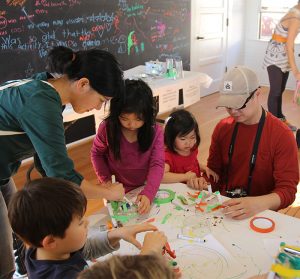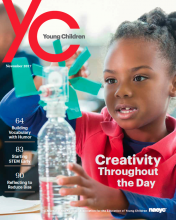
If you follow the news or have a child in school, it’s easy to believe that science, technology, engineering, and math (STEM) concepts are more prominent than ever before. And certainly, the importance of STEM learning and STEM experiences are enjoying a renaissance of media coverage.
The reality is, however, that our children have always been capable of STEM learning, yet we are just now learning more about how and when to encourage this type of thinking in a way that sets the next generation up for future success. For too long, educational practices and adult-child interactions have been influenced by the assumption that children cannot think logically, despite a wealth of research challenging that idea.
In our new publication, The Roots of STEM Success: Changing Early Learning Experience to Build Lifelong Thinking Skills experts from the Center for Childhood Creativity (CCC) at the Bay Area Discovery Museum (BADM) detail the critical importance of sharing STEM experiences with the youngest learners, children ages 0-8.
Through the review of more than 150 empirical studies, the authors of The Roots of STEM Success reached conclusions about early STEM learning that are echoed in the Joan Ganz Cooney Center’s own report, STEM Starts Early. Namely, that children can grapple with STEM concepts even before their first birthday, and need to be exposed to these critical learning experiences during this stage of development. Both publications suggest too that parents, teachers, and other caregivers need to be better prepared and empowered to share these learning experiences with young children in both formal and informal learning spaces.
The Roots of STEM Success shares six key findings designed to help parents, informal and formal educators, and other caregivers understand the importance of an early STEM focus. We know that children’s earliest experiences lay the foundation for their lifelong creative problem-solving and thinking skills and shape their approach to learning. It is vital that we get this message to the community charged with raising this future generation of global citizens.
Part of that process is sharing practical, actionable tips that adults will feel comfortable putting into practice during their interactions with young children. In their authorship of The Roots of STEM Success, CCC experts considered how they might translate the research they reviewed into experiences that would make sense for daily life and could be implemented in both formal and informal education spaces, including schools, homes, and community centers, among others.
Some of these tips, such as providing time and space for make-believe play or asking “WH questions” (such as why, what, and how) may be things that some parents and teachers are already doing. Others, such as praising children for their effort rather than their ability and adopting a “love of mistakes” may be completely unfamiliar.
What The Roots of STEM seeks to do is present all these tips in an approachable way, so that caregivers can feel equally comfortable implementing those that are the most familiar and those that are completely new to them. The tips are also shared in a way that empowers adults to understand why they are important to STEM learning. For instance, a tip encouraging adults to use conceptually rich vocabulary with their children—describing a block tower as “stable” or a pair of socks as “matching”—connects this practice with the way babies develop language.
All of the publication’s practical tips are backed by research, and CCC experts see them implemented everyday through the work of the Bay Area Discovery Museum. Because of the partnership between BADM and the CCC, children at the museum’s site are able to engage in creative, research-backed, STEM-based programming on a daily basis.

Visitors to BADM—from infants at Tot Spot to children in our Science Lab programs to the parents and adults that accompany them—are exposed to creative learning at every turn. While we are grateful to have this space to share these STEM-based programs and activities, we know that more needs to be done to allow all children to access these critical learning experiences, so they can reach their full potential later in life.
What the CCC ultimately hopes to achieve—through publications like The Roots of STEM Success, local and national speaking engagements, and the creation of practical resources—is a rethinking of STEM education. Our current definition and understanding must expand: to recognize learning spaces other than traditional classrooms; to identify more opportunities to share meaningful STEM experiences; and, most importantly, to include our youngest learners from their first years of life.
To read The Roots of STEM Success: Changing Early Learning Experiences to Build Lifelong Thinking Skills, along with other CCC publications, please click here.
 Helen Hadani, Director of Research for the Center for Childhood Creativity, authors original research on creative thinking and child development, including the Center’s latest report The Roots of STEM Success, to create evidence-based tools and resources for educators and parents. She launched and manages the Center’s onsite research lab at the Bay Area Discovery Museum and partners with U.C. Berkeley and Stanford University to conduct empirical research on cognitive, social and emotional development, with a focus on creative thinking and problem solving. She brings more than 18 years of experience in research and education settings, including years in the technology and toy industries conducting research with parents and children to develop innovative products at Hasbro, Apple, Leapfrog, and LEGO. Helen received her doctorate in Developmental Psychology from Stanford University and has taught at U.C. Davis and San Francisco State University. She is the co-author of a chapter on research and museum partnerships in the book Relating Research and Practice: Cognitive Development in Museum Settings.
Helen Hadani, Director of Research for the Center for Childhood Creativity, authors original research on creative thinking and child development, including the Center’s latest report The Roots of STEM Success, to create evidence-based tools and resources for educators and parents. She launched and manages the Center’s onsite research lab at the Bay Area Discovery Museum and partners with U.C. Berkeley and Stanford University to conduct empirical research on cognitive, social and emotional development, with a focus on creative thinking and problem solving. She brings more than 18 years of experience in research and education settings, including years in the technology and toy industries conducting research with parents and children to develop innovative products at Hasbro, Apple, Leapfrog, and LEGO. Helen received her doctorate in Developmental Psychology from Stanford University and has taught at U.C. Davis and San Francisco State University. She is the co-author of a chapter on research and museum partnerships in the book Relating Research and Practice: Cognitive Development in Museum Settings.




